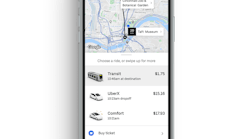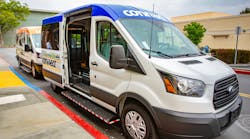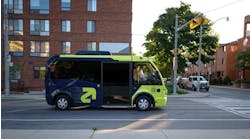Uber vows to provide fully zero-emission platform by 2040
Most of the world is looking to regain some level of normalcy during the current COVID-19 pandemic. However, Uber is actively working to keep one element trending down: Carbon emissions.
During a press call on Sept. 8, Uber noted carbon emissions fell 17 percent in early April when two-thirds of the world’s population was under lockdown orders, but by June, the decrease in year-over-year carbon emissions was only five percent.
“During lockdown, blue skies replaced smog above city skylines. Pollution levels fell and wildlife returned,” said Uber CEO Dara Khosrowshahi on a Sept. 8 press call. “The pandemic has caused many cities to rethink their infrastructure, transforming parking into parks and creating more space for walkers and cyclists. We’ve had a glimpse of what life could be like with less traffic and cleaner air—in cities built for people, not for cars.”
Khosrowshahi does not want to go back to business as usual and is acknowledging the company’s place as the “largest mobility platform in the world” to do more to address climate change.
Uber has committed to become a fully zero-emission platform by 2040. In U.S., Canadian and European cities, 100 percent of rides will take place in electric vehicles by 2030. In addition to the company’s platform goals, Uber also committed to reaching net-zero emission from its corporate operations by 2030.
Uber announced a series of four actions to support the zero-emission goals and include:
- Expanding Uber Green;
- Helping drivers transition to electric vehicles;
- Investing in a multimodal network; and
- Being transparent and accountable.
Uber Green is a new option launched in 15 U.S. and Canadian cities on Sept. 8 where users can specifically request a ride in an electric or hybrid vehicle. By the end of the year, Uber says this option will be available in 65 cities globally.
The company is committing more than $800 million in resources to help its drivers in the U.S., Canada and Europe transition to battery electric vehicles by 2025. Drivers will be provided financial incentives to drive electric cars and the company will work with auto manufacturers and local governments encourage the transition to electric vehicles.
To support accountability, Uber released its first Climate Assessment and Performance Report. Uber says the report’s publication makes it one of the first companies to more broadly measure and report on emissions from customers’ real-world use of its products.
For the transit industry, Uber’s commitment to invest in its multimodal network holds the most interest.
This investment will be put into three buckets including further integration of Lime bikes and scooters into the Uber app. Lime is currently offered in more than 55 cities globally, which is double the availability in 2019.
Second will be the expansion of shared rides. David Reich, head of Uber Transit, told attendees on the press call that the company has not given up on Uber Pool and plans to relaunch the option when it is safe to do so. Until then, the company will expand its Nonstop Shared Rides option, which offers users a last-in, first-out carpooling option.
The third bucket will be continued partnerships with transit agencies “to avoid the return to traffic gridlock and pollution.”
Uber is expanding its Journey Planning feature to six new cities and plans to bring the feature to a total of 40 cities by the end of 2020. In-app ticketing, which launched in Denver in 2019, has been rolled out to more than 10 cities this year through its partnership with Masabi.
Uber also launched a new multimodal feature – UberX and Transit – in the Uber app, which will initially be available in Chicago and Sydney, Australia. Riders can tap this option and plan their journey with a mix of UberX, walking directions and bus, subway or train connections. Uber says the option is powered through real-time transit information and Uber’s on-demand mobility network.

Mischa Wanek-Libman | Group Editorial Director
Mischa Wanek-Libman is director of communications with Transdev North America. She has more than 20 years of experience working in the transportation industry covering construction projects, engineering challenges, transit and rail operations and best practices.
Wanek-Libman has held top editorial positions at freight rail and public transportation business-to-business publications including as editor-in-chief and editorial director of Mass Transit from 2018-2024. She has been recognized for editorial excellence through her individual work, as well as for collaborative content.
She is an active member of the American Public Transportation Association's Marketing and Communications Committee and served 14 years as a Board Observer on the National Railroad Construction and Maintenance Association (NRC) Board of Directors.
She is a graduate of Drake University in Des Moines, Iowa, where she earned a Bachelor of Arts degree in Journalism and Mass Communication.






